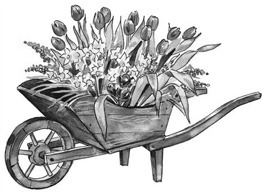Creating Water Spaces for Pollinators
Gardeners spend time and money to thoughtfully provide our pollinators with a variety of food plants, nesting options, and shelter. However, we might not always consider another vital element for our pollinator havens – water.
Water is essential for healthy pollinators, and there are many small things we can do to establish water sources for the assortment of dragonflies, bees, wasps, hummingbirds, butterflies, and bats that visit our outdoor spaces. These creatures need water for digesting their food, hydrating, bathing, building nests, regulating body temperature, reproducing, and foraging. Fun fact: honeybees collect water and spit the droplets into the hive while fanning their wings, helping to cool the hive.
In addition to creating water sources for pollinators, we should also supply our plants with enough water so they can continue to provide food and nectar. In dry conditions, waterstressed plants are shorter, produce fewer and smaller flowers, and yield lower volumes of nectar and pollen. Plant reproductivity is also affected, potentially stunting seed and fruit development.
Healthy, flowering plants are dependent on pollinators and, conversely, pollinators are dependent on blossoming plants -- water bonds their relationship. Your garden strategy should include a water-enriched environment for a healthy ecosystem.
Water sources do not have to be complicated or expensive; they can be as simple as a puddle or as complex as a pond. Garden plants, such as sedum whose leaves puddle with water after a rainstorm, can offer a temporary natural watering spot. However, placing artificial watering stations throughout your yard is critical if there are limited natural water sources such as dew, streams, rain puddles, and ponds, especially during prolonged dry spells.
It’s important to distribute a variety of watering stations around your yard to meet the specific needs of the species you want to support. For example, bees cannot swim, so place shallow dishes with pebbles or floating platforms like twigs for perching, resting, and sipping water. Butterflies favor damp soil or containers with damp sand to extract moisture, salts, and minerals with their proboscis. Dragonflies prefer fresh-water and pond-type habitats, while bats drink on the wing, swooping down to pools or slow-moving water.
Here are some tips for placement and maintenance of water sources:
• Ensure water stations are accessible, with cover from harsh elements and predators.
• Place water sources near flowering plants to provide spots for resting and drinking.
• Set dishes in partially shady locations to limit evaporation and overheating.
• Keep water sources away from high-traffic locations.
• Clean and change water frequently since stagnant, dirty water can become a breeding ground for mosquitoes, bacteria, or parasites.
• Remove algae and other debris often.
• Avoid chemically treated/chlorinated water.
In addition to supporting pollinators, adding water to our gardens has the benefit of attracting other animals such as frogs, chipmunks, and birds. When we establish water spaces, we are actively creating a healthy and inviting garden for a variety of creatures, making our yards even more interesting and interactive.


